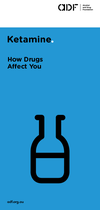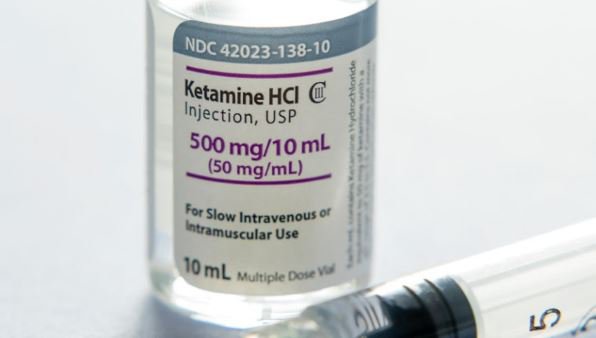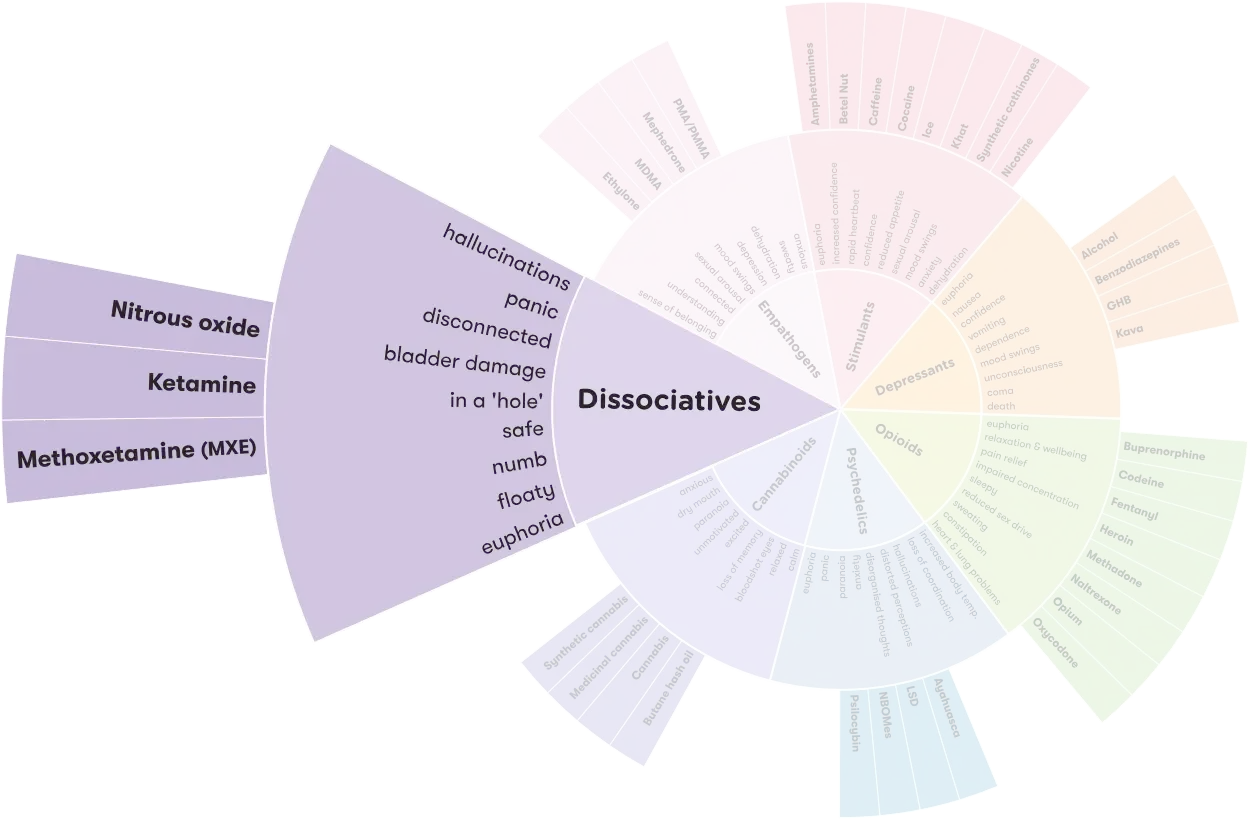
Ketamine: How drugs affect you (bundle of 50)
Pamphlets
$36.32 (inc. GST)
View in ADF Shop
How is ketamine used?
Ketamine can be swallowed, snorted or injected. It’s also sometimes smoked with cannabis or tobacco. The effects of ketamine may be experienced within one minute if injected, 5–15 minutes if snorted, and up to 30 minutes if swallowed. Its effects can last for around an hour, however an individual’s coordination or senses may be affected for up to 24 hours after initial use.4
Effects of ketamine
Use of any drug can have risks. It’s important to be careful when taking any type of drug.
Ketamine affects everyone differently, based on:
- size, weight and health
- whether the person is used to taking it
- whether other drugs are taken around the same time
- the amount taken
- the strength of the drug (varies from batch to batch)
The following effects may be experienced:
- feeling happy and relaxed
- feeling detached from your body
- lowered sensitivity to pain
- visual and auditory hallucinations
- confusion and clumsiness
- increased heart rate and blood pressure
- drowsiness
- slurred speech and blurred vision
- anxiety and panic
- vomiting
- Going into a k-hole (intense detachment from reality, usually only happens at high doses).3,4,6
Overdose
If you take a large amount of ketamine or have a strong batch, you could overdose.
The risk of death from ketamine alone is low, due to its ability to cause unconsciousness with minimal impact on airway reflexes or blood circulation.6 However, individuals are at a higher risk of physical harm/accidents while under the influence of the ketamine.6
Call an ambulance straight away by dialling triple zero (000) if you, or someone else, has any of the following symptoms (Emergency services are there to help and can provide instructions over the phone):
- difficulty breathing
- blurred vision
- high blood pressure, fast heartbeat
- convulsions/seizures
- delirium or psychosis
- unconsciousness.3,4,6
Coming down
The day after using ketamine, you may experience:
- memory loss
- impaired judgement, disorientation
- irritability and restlessness
- clumsiness
- aches and pains
- anxiety.1,3,7
Long-term effects
Regular use of ketamine may eventually cause:
- flashbacks
- poor sense of smell (from snorting)
- mood and personality changes, depression
- poor memory, thinking and concentration
- abnormal liver or kidney function
- ketamine bladder syndrome (see below)
- abdominal pain
- needing to use more to get the same effect
- dependence on ketamine
- financial, work and social problems.3,6
Ketamine bladder syndrome
Large, repeated doses of ketamine may eventually cause ‘ketamine bladder syndrome’ – a painful condition needing ongoing treatment.
Symptoms include difficulty holding in urine, incontinence, which can cause ulceration in the bladder.
Anyone suffering from ketamine bladder syndrome should speak to a health professional immediately.3
Ketamine and mental health
Clinical trials and studies have assessed ketamine as a treatment for depression and shown good results.7 Currently, ketamine (esketamine hydrochloride) in the form of a nasal spray is available for treatment-resistant depression in Australia.
Daily users of ketamine can experience psychotic-related symptoms, especially among people who have a history of mental illness.4
Tolerance and dependence
People who regularly use ketamine can become dependent on the drug. They may feel they need ketamine to go about their normal activities like working, studying and socialising, or just to get through the day. They may also develop a tolerance to it, which means they need to take larger amounts of ketamine to get the same effect.3
Mixing ketamine with other drugs
Mixing ketamine with other drugs can have unpredictable effects and increase the risk of harm.
- Ketamine and alcohol: nausea and vomiting at lower doses. Can lead to more serious effects at higher doses such as passing out and vomit aspiration.
- Ketamine and benzos/opioids/GHB: nausea, vomiting, vomit aspiration, difficulty breathing, passing out, and possible death.
- Ketamine and ice/speed/cocaine: increase in blood pressure.8
Use of more than one drug or type of drug consumed at the same time is called polydrug use.4
More on Polydrug use
Polydrug use is a term for the use of more than one drug or type of drug at the same time or one after another. Polydrug use can involve both illicit drugs and legal substances, such as alcohol and medications.
Reducing harm
There are ways in which you can reduce the risk of harm when using ketamine:
- start with a lower dose until you know how the drug affects you personally
- consider the impact of your mood and the environment you are in before you use ketamine
- avoid using alone
- make sure the drug is crushed into a fine powder so it doesn’t cause cuts
- snorting drugs repeatedly over time can injure the nose, remember to take breaks
- you can snort water before and after use to reduce infection risk
- avoid driving, operating machinery or swimming as ketamine slows reflexes and impairs coordination
- consider having a person to 'trip sit'. A person who remains sober and that can help out if needed.8-10
Withdrawal
Giving up ketamine after using it for a long time is challenging because the body has to get used to functioning without it. Symptoms include:
- cravings for ketamine
- no appetite
- tiredness
- chills, sweating
- restlessness, tremors
- nightmares, anxiety, depression
- irregular and rapid heartbeat.3,4
Getting help
If your use of ketamine is affecting your health, family, relationships, work, school, financial or other life situations, or you’re concerned about someone else, you can find help and support.
Call the National Alcohol and Other Drug Hotline on 1800 250 015 for free and confidential advice, information and counselling about alcohol and other drugs
Help and Support Services search
Find a service in your local area from our list. Simply add your location or postcode and filter by service type to quickly discover help near you.
If you're looking for other information or support options, send us an email at druginfo@adf.org.au
Path2Help
Not sure what you are looking for?
Try our intuitive Path2Help tool and be matched with support information and services tailored to you.

In Australia, legally produced ketamine is a restricted substance and only a doctor/specialist or vet may prescribe or administer it. All other forms of ketamine are illegal in Australia.
Federal and state laws provide penalties for possessing, using, making, selling, importing or exporting, or driving under the influence of ketamine.
See also, drugs and the law.
National
- 3.1% of Australians aged 14 years and over have used ketamine one or more times in their life.11
- 0.9% of Australians aged 14 years and over have used ketamine in the previous 12 months.11
Young people
- Young Australians (aged 14–29) first try ketamine at 20.4 years on average.11
- Li L, Vlisides PE. Ketamine: 50 Years of Modulating the Mind. Frontiers in Human Neuroscience [Internet]. 2016 [10.11.2023]; 10.
- United States Drug Enforcement Agency Administration. Ketamine 2020 [13.11.2023].
- Morgan CJA, Curran HV. Ketamine use: a review. Addiction [Internet]. 2012 [16.03.2023]; 107(1):[27-38 pp.].
- Tucker JA, Darke, S, Lappin, J, Farrell, M. The Clinicians Guide to Illicit Drugs and Health: Silverback Publishing; 2019 [26.10.2023].
- Nutt D. Drugs without the hot air : making sense of legal and illegal drugs. Cambridge: UIT Cambridge Ltd; 2012 [10.10.2023].
- Kalsi S Wood D Dargan P. The epidemiology and patterns of acute and chronic toxicity associated with recreational ketamine use. Emerging Health Threats Journal [Internet]. 2011 [13.11.2023]; 4.
- Zarate C Niciu M. Ketamine for depression: evidence, challenges and promise. World Psychiatry [Internet]. 2015 [13.11.2023]; 14(3):[348–50 pp.].
- Hi-Ground. Ketmaine n.d. [cited: 23.11.2022].
- Harm Reduction Victoria. Ketamine n.d. [cited: 23.11.2022].
- Psychonaut Wiki. Ketamine 2022 [cited: 24.11.2022].
- Australian Institute of Health and Welfare. National Drug Strategy Household Survey 2019 Canberra: AIHW; 2020 [11.04.2023].

